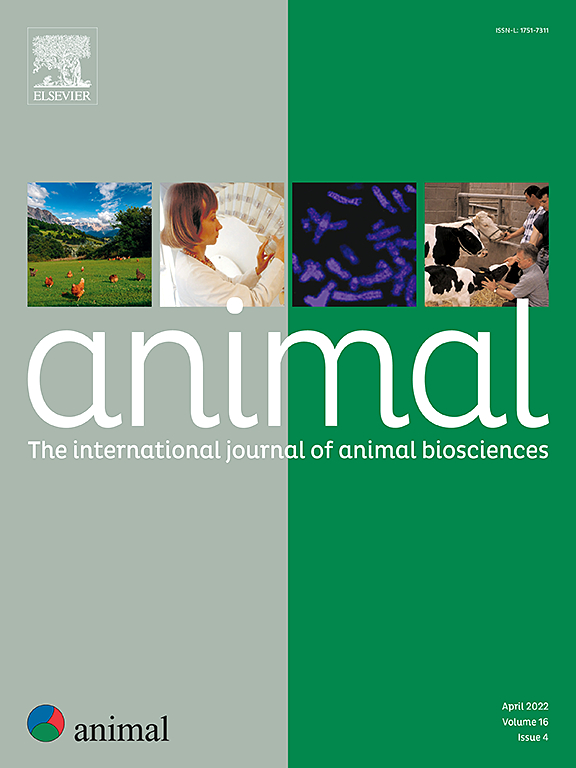Review: Nutritional, safety, and environmental aspects of former foodstuff products in ruminant feeding
IF 4.2
2区 农林科学
Q1 AGRICULTURE, DAIRY & ANIMAL SCIENCE
引用次数: 0
Abstract
As a consequence of global population growth, rising incomes, urbanisation, and improved household economics, the demand for animal products is expected to increase. This has led to a heightened focus on the challenge of allocating natural resources between the production of human food and livestock feed. The livestock industry, particularly ruminant producers, is seeking cost-effective, human-inedible feed alternatives due to the rising costs of forage production and grains. Former foodstuff products (FFPs), derived from food industry leftovers (material remnants of food processing), represent a promising strategy for reducing feed–food competition, particularly through partial replacement of grains and concentrate feed in ruminant diets. FFPs are rich in simple sugars and fats; however, their excessive intake by ruminants may increase the risk of subacute rumen acidosis and modulate microbial protein synthesis and methane emissions. Furthermore, chemical substances present in FFPs (polyphenols and theobromine), packaging remnants, and microbiological contaminants may alter ruminal ecosystems and fermentation, methane emissions, milk quality, and animal health. This review summarises the nutritional composition of FFPs, with a focus on their potential to replace energy feeds, the risks and benefits of FFPs in ruminant nutrition, and legislation regarding the use of FFPs in livestock diets. It concludes by highlighting further research that could promote sustainable FFP practices.
综述:反刍动物饲养中原食品的营养、安全和环境问题。
由于全球人口增长、收入增加、城市化和家庭经济改善,对动物产品的需求预计将增加。这使人们更加重视在人类粮食生产和牲畜饲料生产之间分配自然资源的挑战。由于饲料生产和谷物成本不断上升,畜牧业,特别是反刍动物生产者,正在寻求具有成本效益的、人类不可食用的饲料替代品。来自食品工业剩余物(食品加工的物质残余物)的前食品产品(FFPs)代表了减少饲料-食品竞争的一种有希望的战略,特别是通过部分替代反刍动物日粮中的谷物和精料饲料。FFPs富含单糖和脂肪;然而,反刍动物过量摄入它们可能会增加亚急性瘤胃酸中毒的风险,并调节微生物蛋白质合成和甲烷排放。此外,FFPs中存在的化学物质(多酚和可可碱)、包装残留物和微生物污染物可能会改变瘤胃生态系统和发酵、甲烷排放、牛奶质量和动物健康。本文综述了FFPs的营养成分,重点介绍了其替代能量饲料的潜力,FFPs在反刍动物营养中的风险和收益,以及在牲畜日粮中使用FFPs的立法。报告最后强调了可以促进可持续FFP实践的进一步研究。
本文章由计算机程序翻译,如有差异,请以英文原文为准。
求助全文
约1分钟内获得全文
求助全文
来源期刊

Animal
农林科学-奶制品与动物科学
CiteScore
7.50
自引率
2.80%
发文量
246
审稿时长
3 months
期刊介绍:
Editorial board
animal attracts the best research in animal biology and animal systems from across the spectrum of the agricultural, biomedical, and environmental sciences. It is the central element in an exciting collaboration between the British Society of Animal Science (BSAS), Institut National de la Recherche Agronomique (INRA) and the European Federation of Animal Science (EAAP) and represents a merging of three scientific journals: Animal Science; Animal Research; Reproduction, Nutrition, Development. animal publishes original cutting-edge research, ''hot'' topics and horizon-scanning reviews on animal-related aspects of the life sciences at the molecular, cellular, organ, whole animal and production system levels. The main subject areas include: breeding and genetics; nutrition; physiology and functional biology of systems; behaviour, health and welfare; farming systems, environmental impact and climate change; product quality, human health and well-being. Animal models and papers dealing with the integration of research between these topics and their impact on the environment and people are particularly welcome.
 求助内容:
求助内容: 应助结果提醒方式:
应助结果提醒方式:


